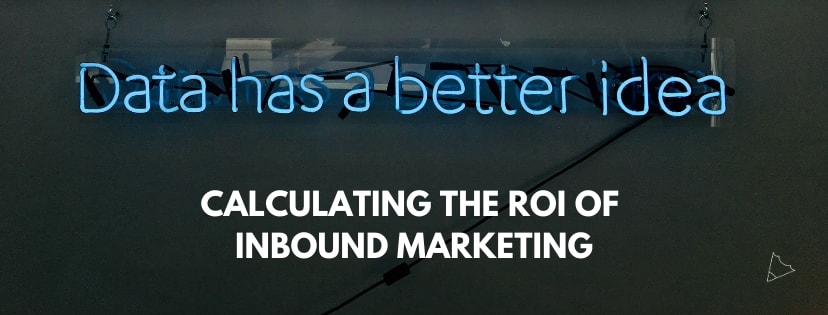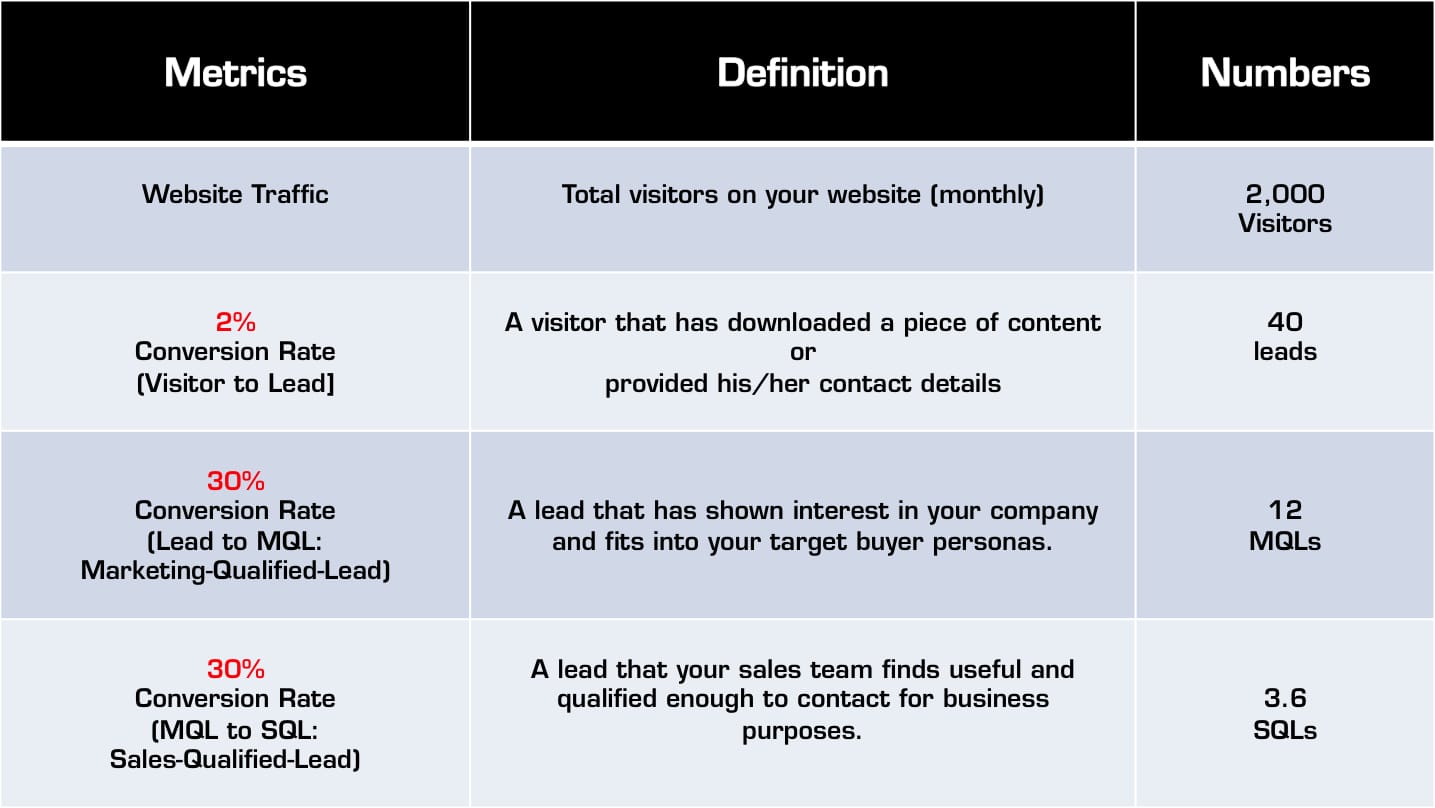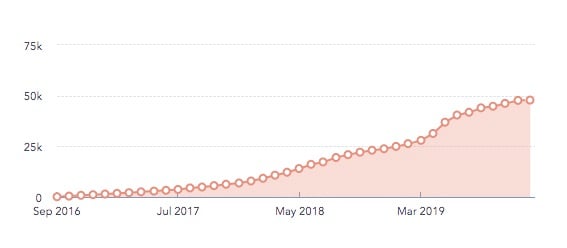
For most businesses out there, inbound marketing is, by far, the most successful long-term digital marketing strategy out there.
The fact that it’s built on trust, content and data makes it bulletproof against shady marketing gimmicks and short-term campaigns to gain quick contracts.
Now, a marketing strategy as robust as inbound requires attention to detail to make the most out of its potential.
And, one of the most important components of the inbound marketing methodology is to measure metrics that bring you customers.
This involves keeping a track of your customers’ digital footprints from the beginning until the end.
Obviously, we’re not asking you to stalk and bombard them with creepy retargeting ads.
Instead, we're asking you to study, analyze and optimize your marketing activities based on the behavior of your customers.
But why is measuring inbound marketing ROI so important?
A simple answer is -
Because it’s the most measurable and scalable form of marketing that ever existed!
After all, who doesn’t want to grow their business by finding that magic formula that works for them?
Successful entrepreneurs and marketers don’t make critical business decisions based on feelings and assumptions.
They make their decisions based on data.
In the words of Sherlock Holmes, “It is a capital mistake to theorize before one has data.”
Data is, no doubt, the secret sauce of your inbound marketing campaigns.
But, where does one find this data?
In your marketing analytics!
Analyzing these marketing metrics will help you understand the ROI of your inbound marketing strategy.
To assign a monetary value to your inbound marketing results, we recommend adopting a closed-loop approach.
But what is “closed-loop marketing/reporting”?
With a closed-loop marketing approach, you can track every step of a customer - from their first conversion as a visitor, until the time they gave you business.
This approach allows you to identify and scale the techniques that work the best for your business.
By documenting every step and creating a fool-proof, closed-loop marketing ecosystem, you can get detailed data on metrics like:
- Best sources of revenue
- How much each customer costs to acquire
- Predictive analysis based on historic and present data
and so much more!
Measuring Your Metrics
Measuring the metrics stated above and below isn’t a mammoth task.
You just need the right mindset, tools and direction towards the metric you’re trying to measure.
It’s easier when you use CRM softwares like HubSpot, because it’s built exclusively for marketing businesses.
Otherwise, you can stick with the good ol’ Google Analytics.
As mentioned earlier, tracking your metrics isn’t a task for some specialized data scientist who cracks numbers day & night.
If you understand language and basic mathematics, you’ll be delighted by the data available for tracking your current situation, along with getting insights on combating the weaknesses in your strategy.
The key is to approach analytics with an objective - whether it’s about making better marketing decisions, or making sense of your customer journey.
Analytics reporting, if done rightly, can tell stories worth a thousand words using a few numerical figures.
Most marketers make the mistake of being vague with their ROI-tracking objectives.
Instead of using the already-available, crystal-clear data to map out the results of their marketing spend, they simply report on generic metrics laced with assumptions.
The following chart shows the journey a website visitor goes through and how you can measure their digital footprints.

As promised in the title of this article, following are the 8 most important metrics for tracking inbound marketing ROI:
Metric #1: Website Traffic to Leads
Website traffic is the basis of generating leads online.
If there's no traffic on your website, inbound marketing simply won't work.
That's why, we've prioritized this metric over others, as it answers the most fundamental question:
"How many people are visiting my website and converting into leads"
Measuring this metric will help you understand the backbone of inbound marketing ROI.
After all, website traffic means nothing if it doesn't generate leads for your business.
Here are some crucial numbers to record and compare every month:
- Website Traffic (number of unique visits)
- Marketing Leads (number of form fill-ups, enquiries, etc)
- Visitors-to-Leads Conversion Rate (percentage of website visitors turning into leads)
- Traffic, Leads and Conversion Rate by Source (what are the best sources that generate traffic and leads: organic search, direct, website referrals, email, ppc, social media)
By the way, did you know?
5 months of consistent inbound marketing can reduce the cost per lead by upto 80%! (Source: Eloqua)
Metric #2: Effectiveness of Organic Searches
This metric will help you understand the strength of your SEO strategy.
Questions like, "If I don't run paid ads, how many people are able to find my business organically?" are answered by analyzing this metric.
Figures to take note of:
- Lead Conversions through Organic Search (how many people became leads by finding your website organically)
- Customer Conversions through Organic Search (how many ACTUAL customers did you gain using organic searches)
- Traffic Generated with Branded Keywords (how many people landed on your website organically by entering your brand name. This metric is an indication of robust brand awareness)
- Traffic Generated with Unbranded Keywords (this is a testament to the effectiveness of your content marketing strategy)
Metric #3: Traffic and Leads from Social Media
Social media has transformed from a personal networking platform into a lead-generating beast.
Find out how effective your social media ads are by analyzing the following sub-metrics:
- Lead Conversions from each Social Media Channel (helps you find out what platforms work best for you)
- Customer Conversions from each Social Media Channel (what social media platforms get you the most customers)
- Traffic Generated from each Social Media Channel (what social media channels bring you the highest and best quality traffic)
Analyzing these metrics will help you gauge the ROI of your social media marketing activities.
Metric #4: Landing Page (Content Offers) Conversion Rates
Content offers are a crucial component of inbound marketing.
These free downloadables (ebooks, checklists, infographics, etc) move visitors through your marketing funnel until they eventually become customers.
In order to understand whether your landing page & content offers are effective, this is the metric you must measure.
This is question that gets answered:
"How many people are visiting my landing page and downloading the featured content offer?"
While you're at it, make sure you A/B test your content assets while optimizing them from time to time, to reap the best rewards of inbound marketing analytics.
Metric #5: Marketing to Sales Qualified Leads (Conversion Rates)
Once you've kick-started a proper inbound marketing campaign, you'll notice that website visitors will start accumulating in a so-called marketing funnel.
A certain percentage of website visitors will turn into leads by filling up forms or downloading content offers on your website.
Depending on their lifecycle in the marketing process, a fraction of them will become Marketing Qualified Leads (MQL).
Upon further lead nurturing, some MQLs will turn into Sales Qualified Leads (SQL).
These SQLs are regarded as the highest quality of leads you can generate using inbound marketing, because they've passed multiple levels of filtration before being deemed qualified enough for the sales team to pursue.
All this is made possible using a marketing automation & CRM system like HubSpot that integrates directly with your website to keep track of multiple levels of lead generation and their conversions.
This metric is important because it gives you a qualitative & quantitative view of your website visitors' behavior so that you can optimize their digital journey even further.
In fact, a survey by The Annuitas Group proves states that nurtured leads make 47% greater purchases compared to non-nurtured leads.
It's about time you implement lead nurturing in your marketing campaigns.
Refer to the table underneath to understand conversion nuances of a website with 2,000 monthly visitors - from traffic to leads.

Metric #6: Customer Acquisition Costs - Inbound vs Outbound
It's important to know how much does a customer cost to acquire, in order to gauge the efficiency of your marketing strategy.
Poorly-executed marketing campaigns operate in a loss when it comes to acquiring customers on a budget.
In the realm of inbound marketing, calculating Customer Acquisition Costs (CAC) necessitates the integration of your website with a CRM/Marketing Automation tool in order to find the most accurate cost of getting customers online.
Apart from that, you'll have to take into account external costs that help you acquire the customers you need to grow your business.
If you're using outbound marketing methods, you'll have to consider factors like paid advertising, designing collaterals, distribution, remuneration for manpower, transportation, plus miscellaneous overheads.
Using inbound marketing involves costs like human resources/manpower (creative, technical, media-savvy), along with subscription costs for the CRM software and other additional tools you have in your marketing shed.
Just in case you still favor outbound tactics, just note that inbound leads cost 61% less on average than outbound leads (that's according to a study by HubSpot - the biggest practitioners of inbound marketing in the world)

Metric #7: Customer Lifetime Value
Since inbound marketing has roots in trust-marketing and brand reputation, it's very commendable for reaching out to existing customers in order to reduce churn and improve your customer Lifetime Value (LTV)
Instead of solely focusing on acquiring new customers, shift some of your focus on reaching out and connecting existing customers.
You could keep them engaged using content like new case-studies, upcoming features, company news, events and content that they might find useful, etc.
The list is endless. Just put yourself in their shoes and ask this question:
"What kind of content will my customers find genuinely useful"
The inbound approach of targeting existing customers helps you up-sell, cross-sell and eventually increase your customer LTV.
HubSpot recommends this 5-step process to calculate this metric successfully:
- Calculate average purchase value: Calculate this number by dividing your company's total revenue in a time period (usually one year) by the number of purchases over the course of that same time period.
- Calculate average purchase frequency rate: Calculate this number by dividing the number of purchases by the number of unique customers who made purchases during that time period.
- Calculate customer value: Calculate this number by multiplying the average purchase value by the average purchase frequency rate.
- Calculate average customer lifespan: Calculate this number by averaging the number of years a customer continues purchasing from your company.
- Calculate CLTV: multiply customer value by the average customer lifespan. This will give you the revenue you can reasonably expect an average customer to generate for your company over the course of their relationship with you.

Metric #8: Revenue Generated from Inbound Marketing
This is, by far, the most important marketing metric to monitor when you're pondering over the ROI of inbound marketing.
The main question to ask here is -
“How much business am I generating using inbound marketing?”
Dive deep into your marketing analytics to find out how much revenue is inbound marketing generating month by month, year by year.
With the added presence of certain outbound advertising efforts like social media and PPC, you need to draw a line between leads generated using both outbound and inbound efforts.
In other words, your marketing strategy should be able to capture the differences between these sources in order to understand what’s working, what’s not and how much is each tactic contributing towards your business.
How Inbound Marketing Worked for us at Arcs & Curves:
We implemented inbound marketing back in 2016.
The chart below (obtained directly from our HubSpot dashboard) depicts the growth in our website traffic ever since our inbound marketing effects were launched.

Since then, we’ve benefitted from a steady increase in website traffic, blog subscribers, high quality leads, opportunities for thought-leadership and more!
If we can do it, so can you.
To conclude..
You’re spending on marketing anyways, whether it’s inbound, outbound or a combination of both.
With outbound tactics, you’re investing more money as compared to putting in time and value to solve your prospects’ problems.
With inbound, you’re making your customer the focus of your marketing to create a messaging strategy that resonates and solves their problems while positioning your business as the best brand for them to work with (or buy from)
Outbound may initially show immediate returns and create lots of “brand awareness”, its effects stop as soon as you pull the plug on the campaign or advertising medium.
On the other hand, inbound is the gift that keeps on giving.
The more content you create and promote, the better your chances get at becoming an industry leader that enjoys premium positioning in your customers’ minds.
Are you measuring and getting ROI on your marketing?
Let us know since we’re specialists in solving that exact problem for your business.












